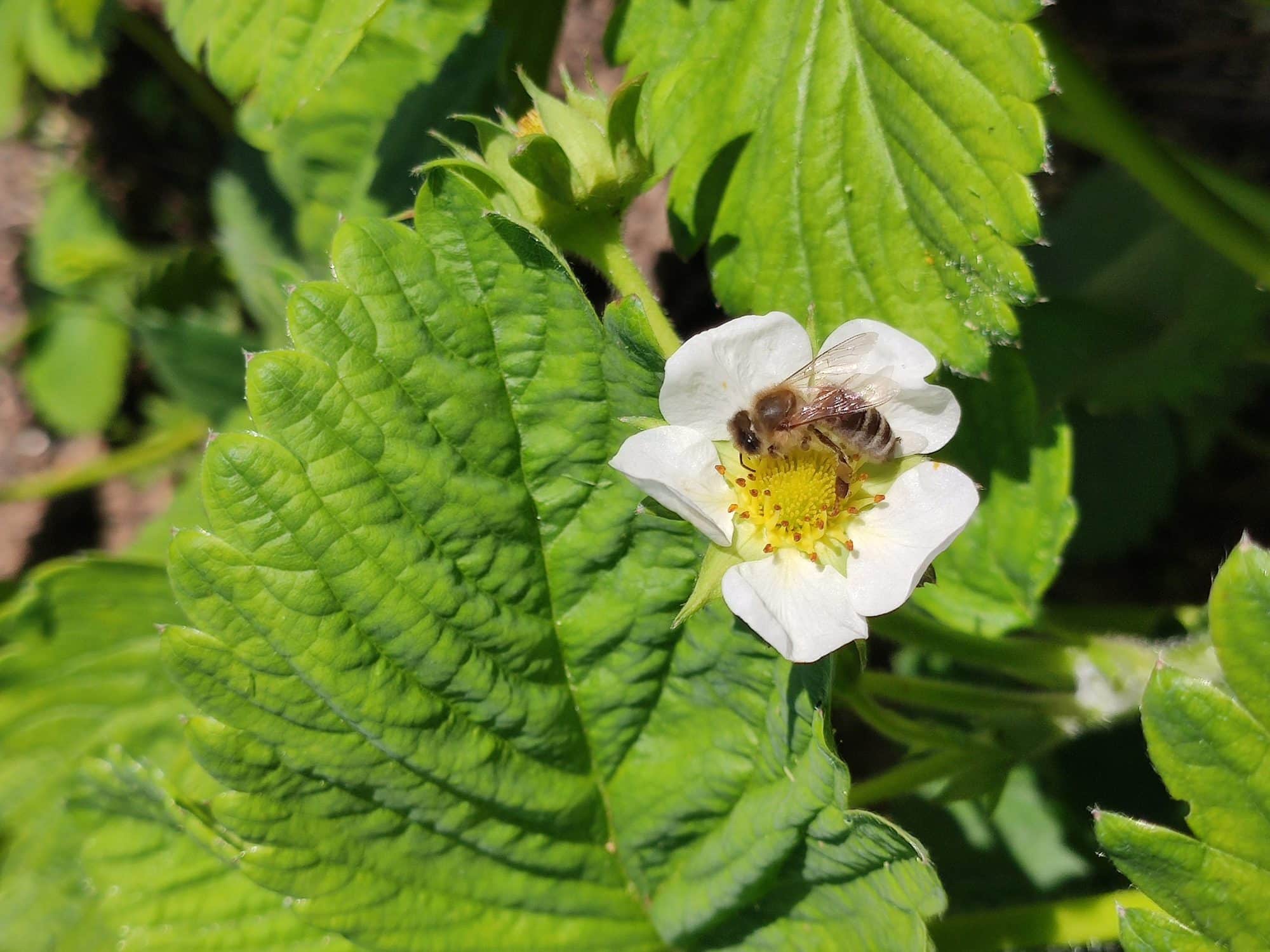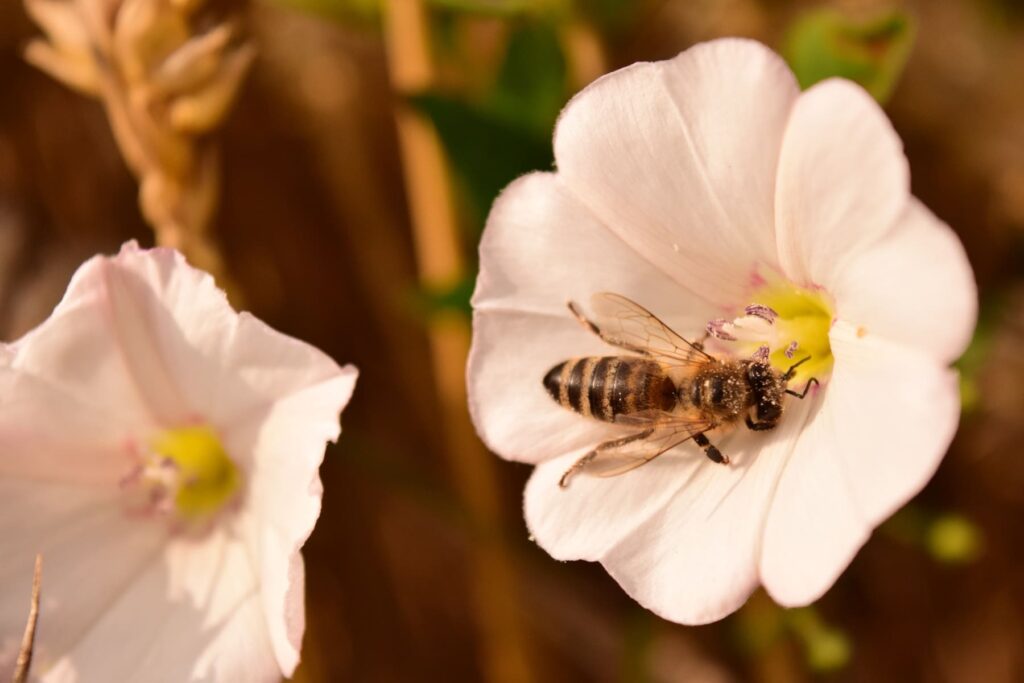Today threatened by the massive use of pesticides and the destruction of their wild habitats, bees nevertheless play an essential role in the natural balance and the preservation of biodiversity. Great pollinators, they contribute to the growth and proliferation of plants, and are therefore essential to the environment. Their disappearance would represent a danger for the planet. So, why not act at our level for our friends the foragers, and make our gardens welcoming shelters? Here are 8 tips to attract, and keep, bees in our plots.
Flowers, flowers, and more flowers to attract them
There is nothing like large flowerbeds to attract bees; they feed mainly on flowers, from which they come to gather nectar and pollen. A gesture that also contributes to the growth of your gardens and the abundance of your blooms.
Contents
- 1 1 Sow single petal row honey plants
- 2 2 Focus on diversity
- 3 3 Prefer blue, green and purple
- 4 4 Encourage native plants
- 5 5 Choose flowers that bloom at different times
- 6 6 Create or install a shelter for bees
- 7 7 Install a Watering Hole for the Bees
- 8 8 Keep Your Garden Wild
- 9 9 Ban The Use of Pesticides
- 10 Author
1 Sow single petal row honey plants
Flowers are a must. Yes, but not just any flowers.
It seems obvious, to attract bees, you have to offer them plants that are interesting for them, that is to say plants known as “melliferous”, which have the particularity of producing a lot of nectar or honeydew (which bees use to make honey). In particular, melliferous plants with a single row of petals are particularly prized, on the one hand because they have more pollen than other flowers, on the other hand because it is easier to reach.
Be careful, then, because not all plants are melliferous. Roses or geraniums, for example, do not produce nectar.
2 Focus on diversity
The goal here is to introduce a wide variety of flowers of different shapes, colors and textures, in order to attract several species of bees. For example, for the wilder beds, dandelions, white clovers and daisies are preferred. If you want more aesthetic beds, you can opt for lavender, crocuses, dahlias, hyacinths, marigolds or sunflowers.
Your garden can also help attract our friends the foragers, if you give priority to vegetables that bloom, such as cucumbers, pumpkins, peppers, or zucchini. Some aromatic plants also produce nectar in large quantities, such as sage, coriander, rosemary, mint or thyme. In the orchard, bees love apple, almond, cherry and pear trees.

3 Prefer blue, green and purple
Like humans, bees have a trichromatic vision of the world. This one is however located at other frequencies of the chromatic spectrum, insofar as the insect is able to distinctly perceive the blue, the green, and the violet (as well as the ultraviolet). It is therefore these colors that, in particular, have their preference. So make sure to favor these tones in your flowerbeds, so that the bees come to buzz in your garden.
4 Encourage native plants
In their natural habitat, foragers are surrounded by wild flowers. It is therefore natural for them to find, in your gardens, the plants that they are familiar with and to which they are accustomed, which will facilitate their arrival, and installation, in this new shelter. So make sure you give preference to wild plants native to your region, which you can accompany with cultivated plants, if necessary. Simply put, the more wildflowers you have, the more bees you will attract.
5 Choose flowers that bloom at different times
Again, it’s all about diversity, this time in terms of flowering. Make sure that flowers bloom at different times of the year to ensure that bees will always find food in your garden.
A nice, attractive garden to keep them there
It’s not enough for bees to come and forage on your flowers to make your garden shine again; they must also stay. So it’s up to you to do everything you can to create a comfortable refuge for them.
6 Create or install a shelter for bees
ECOstyle insect hotel for bees
Not all bees live in hives. There are other species of bees, called “wild” or “solitary” bees, which are used to living alone. In general, they live in small dens made of natural wood (logs with holes, old tree stumps), decomposing vegetation, or even cavities in earthen walls (cob, for example), which they use as a breeding and nesting place. Do not hesitate to create or install these types of nooks and crannies to encourage bees to stay in your home. There are specific insect hotels for bees.
You can also, if you feel like it, install beehives to encourage the installation of honey bees. If you are a beginner, you can choose to make small wooden bee houses.
7 Install a Watering Hole for the Bees
Like all living things, bees need to drink. They need water sources that are specific to their small size and fragility. It would be impossible for them to land on birdbaths, for example, as the water is too deep.
To make a bee bath, all you need is a shallow tray, which you will surround with stones (around the edge), and fill with water. Place the tray close to the honey flowers so that the bees only have to rest gently on the pebbles to drink.

8 Keep Your Garden Wild
The idea is not to let your garden become an abandoned wasteland, far from it. That said, a low-mowed lawn, symmetrical flowerbeds, no mud, dead leaves, or tree stumps will scare away the bees. In other words, they will gladly come to forage on your flowers, but will prefer to settle elsewhere. Remember, bees are still wild animals, so they look for a place similar to their natural habitat.
So keep your plots elegantly cultivated, but don’t hesitate to leave some corners of your garden completely free, so that clover or dandelions can proliferate there. Leave the dead leaves there to serve as a habitat for your protégés.
9 Ban The Use of Pesticides
Pesticides and other plant protection products have disastrous effects on the health of bees. They are completely vulnerable to these chemicals, which affect them by simple contact or ingestion; in the best case, they will lose all their sensory cues and will be unable to find their way around. In the worst case, they will cause their death. If you wish to make your garden an ideal refuge for bees, phytosanitary products, whatever they are, should be banned.
In conclusion, if you plan to attract and welcome bee populations in your garden, be very careful, and make sure to take the usual precautions when approaching flowerbeds and tree stumps. A bee that feels threatened will sting to defend itself. The experience is not recommended for people with allergies to bee stings.


